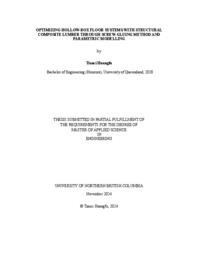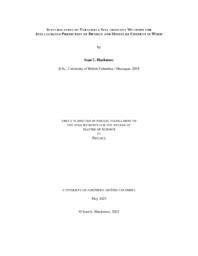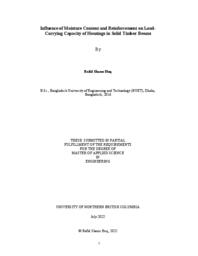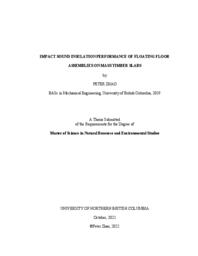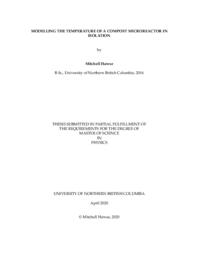Gehloff, Maik
Person Preferred Name
Maik Gehloff
Related Works
Content type
Digital Document
Origin Information
Content type
Digital Document
Origin Information
Content type
Digital Document
Description / Synopsis
Mass timber panels are frequently utilized as load-bearing components in the construction of floors, walls, and roofs within mid-rise or high-rise wooden buildings. In comparison to other building materials like concrete and steel, floors constructed using mass timber panels have relatively lighter weight and lower bending stiffness, which makes them more susceptible to vibrations resulting from human activity. The floor vibration can significantly affect the comfort of its occupants, and the vibration serviceability limit design often governs the maximum allowable span of mass timber floors. The limited quantity and complexity of research on the vibration performance of mass timber floors underscore the urgent need for further investigation. This research focused on assessing the vibration performance of mass timber slab floors with beam supports and concrete toppings. The two investigations included experimental tests to determine the dynamic properties of these floors and gathered subjective ratings from occupants to evaluate the floor's vibration performance. Additionally, numerical modeling approaches were suggested in each study and verified by using test results. The applicability of three contemporary design methods for timber floor vibration was assessed by comparing the experimental results with the predictions generated by each method. The results of this research have highlighted the significant influence of support stiffness on the vibration performance and dynamic properties of mass timber slab floors. Transitioning from rigid wall supports to realistic beam supports can cause a notable shift in the floor's vibration performance, potentially moving it from acceptable to unacceptable. In such cases, the fundamental natural frequency can decrease by more than 40%, but the deflection under point load remained consistent. The method proposed by Kollar demonstrated a remarkable level of accuracy in predicting the fundamental natural frequency of beam-supported floors. The impact of adding a floating concrete topping to the floor's dynamic properties depends on specific construction details like support conditions and floor-to-concrete thickness ratio. Within this research, introducing a floating concrete topping to mass timber floors significantly improved their vibration performance. This improvement had the potential to change the initial subjective rating of the floor from unacceptable to acceptable. Various degrees of partial composite action were observed between the concrete and timber layers depending on different floor assemblies. The commonly used floor vibration design methods exhibited limitations when employed in the design of mass timber floors with varying construction details. To achieve more accurate predictions of their vibration performance, future study is recommended.
Origin Information
Content type
Digital Document
Description / Synopsis
Timber construction is a sustainable solution to address the increasing global demand for housing. Timber framing currently uses mostly mechanical fasteners, which are made from metals with high carbon footprint, and – depending on the type of fasteners– provide poor aesthetics. These challenges can be addressed by using traditional joints such as timber housings. However, there are no design guidelines available that account for the joint geometric parameters, the wood moisture content during fabrication and when loaded as well as the impact of mechanical reinforcements. This thesis extends on previous research to investigate the influence of wood moisture and reinforcement on the load-carrying capacity of solid timber beams with housings. A total of 60 beams with single housings and 30 beams with double housings were prepared and tested while varying the moisture condition (either wet or dry) at the time of cutting the housings and at the time of testing the beams. Along with 32 test data from previous research, statistical analysis was conducted to evaluate the statistical significance of the investigated parameters. In addition, 198 small-scale specimens were tested for shear, tension and compression to evaluate the impact of small clear specimen material strength on the beam load-carrying capacity. The tests confirmed that larger depth below the mortise and the use of self-tapping screws as reinforcement lead to increase of load-carrying capacity; however, the moisture condition during cutting and testing was only shown to have a significant impact on the load-carrying capacity of double housings, but not single housings. The correlation between the material strength tests and load-carrying capacities demonstrated that the strength of small clear specimens from the same beam had no influence on the load-carrying capacity of the housings.
Origin Information
Content type
Digital Document
Description / Synopsis
Mass timber buildings become increasingly popular in North America and worldwide. Mass timber panels are mainly used structural slabs in mass timber buildings. However, due to the lightweight and low-stiffness of mass timber panels, the human induced impact sound on floors has been identified as an issue to be solved. Floating concrete topping is a common solution adopted for insulating the impact sound transmission through the mass timber slabs. However, there is few guidance on designing floating concrete floor assemblies and high performance floating floor assemblies for mass timber slabs. In this study, the relationship between concrete topping thickness, dynamic stiffness of elastic interlayers and the impact sound insulation performance of continuous floating concrete assemblies was first investigated according to ASTM test standard. It was found that the floor assemblies with lower apparent dynamic stiffness of elastic interlayer and thicker concrete topping had higher apparent impact insulation class (AIIC) ratings, but limited under 53 dBA without additional floor finish. The empirical prediction equation overestimated the improvements of floating concrete toppings on mass timber slabs. Then, a series of discrete floor raised floor assemblies using elastic mounts were tested using the tapping machine. The results showed AIIC rating of the discrete raised floating floor reached up to 65 dBA. At last, the low frequency (50 to 630 Hz) impact sound insulation performance was conducted according to JIS standard using the ISO rubber ball. With the comparison of sound pressure level (SPL) spectra among ISO rubber ball, ISO tapping machine and real adult walking on both bare floor and different floating floor assemblies, the ISO rubber ball was found to be a suitable source simulating human foot fall noise. The raised discrete floating floor still demonstrated outstanding impact sound insulation performance. However, the correlation between corrected maximum sound pressure level (LFmax) index and apparent impact insulation class (AIIC) was very low. Overall, the floating floor assemblies had similar performance regardless of the type of mass timber slabs as long as the slabs had the same thickness and wood species.
Origin Information
Content type
Digital Document
Description / Synopsis
A mixture of waste-wood biomass and municipal biosolids waste was composted in a plastic container inside of an insulated chamber. The mixture of biomass and biosolids was approximately 50:50 and weighed 82.6 kg. The peak temperature of the compost was 32.4◦C. The small scale of the compost system allowed the lower limit of the compost decomposition rate to be studied. A model was successfully developed to predict the core temperature of the compost using the ambient temperature in the insulated chamber. A literature review was conducted to determine literature values for the overall convective and conductive heat transfer coefficient, the dry mass fraction, and heat of combustion for both biomass and biosolids. The model used an optimization algorithm to calculate the rate constant for the experimental setup. The calculated decomposition rate constant was 0.0525 Day−1.
Origin Information
Content type
Digital Document
Description / Synopsis
The widespread availability of Cross-laminated timber (CLT) provides opportunities to extend the use of wood beyond traditional low-rise residential construction. Glued-in rods (GiR) are an interesting technical solution for numerous structural applications in timber engineering. Although GiR connections have the potential to be used in combination with CLT, research on this application is scarce. In this thesis, an experimental investigation on the performance of GiR in CLT is presented. Two different 5-ply CLT panel thicknesses (139 and 175 mm), two steel rod diameters (d = 12.7 and 19.1 mm) and five different anchorage lengths (la = 6d, 10d, 12d, 14d and 18d) were considered in single and multiple rod connections. A total of 260 specimens were fabricated and subsequently tested under uni-axial quasi-static monotonic tension. The results were assessed in terms of load-carrying capacity, stiffness and failure modes and demonstrated that GiR in CLT offer an alternative high capacity timber connection.
Origin Information

